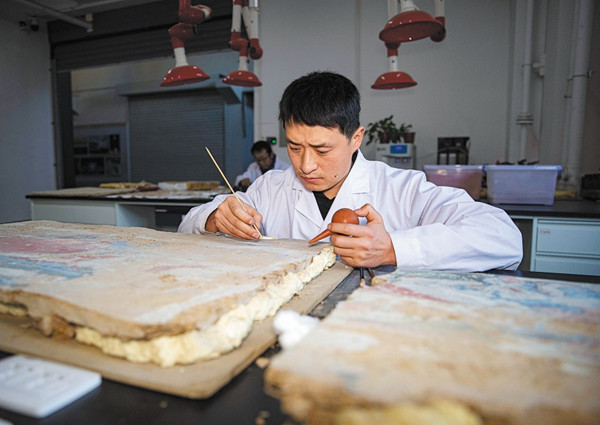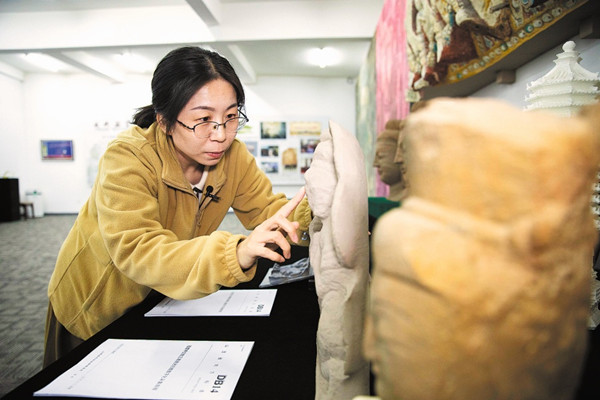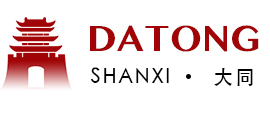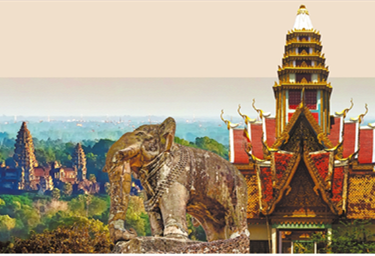Young people work to preserve precious past

Dai Yuxiang renovates a piece of ancient mural at the institute. [Photo provided to CHINA DAILY]
The Yungang Grottoes in Datong, Shanxi province, listed as a UNESCO World Heritage Site with a history that goes back more than 1,500 years, has attracted a team of young researchers to protect and expand its influence.
As one of the three major grotto sites in China, the grottoes extend about 1 kilometer from east to west, and were all carved out of the mountain.
The 254 extant grottoes consist of 45 major caves and more than 51,000 sculptures from the fifth century, representing some of the oldest carved art in the world.
The Yungang Research Institute, which was known as the Yungang Grottoes Research Institute until 2021, is responsible for protecting, researching, monitoring and exhibiting the Yungang Grottoes, as well as coordinating the development of Yungang studies and the protection of regional grottoes.
At the institute, a group of young researchers are busy restoring the grottoes in an attempt to preserve the precious cultural relics and allow more people to access them.
Through the establishment of archives and a digital technology collection, they conduct comprehensive research of the site and explore methods of protection.
Bent over his desk, Dai Yuxiang carefully used a suction ball to remove white ash from pieces of a mural.
"The suction ball is originally a medical tool used in otolaryngology (the field of ear, nose and throat medical treatment)," Dai said. "During the removal process, it can help me blow away the detached white ash and powder."
Dai, 38, is mainly engaged in the protection and restoration of painted clay murals at the institute. He also gives students lessons on restoration. "My work can be divided into two parts," he said. "We first conduct the restoration on-site. Then, if the mural has been severely damaged, it will be removed and restored indoors."
Sometimes, the restoration work creates pressure for Dai.
In June 2019, Dai participated in the restoration of murals at an ancient tomb from the Northern Wei Dynasty (386-534) in Datong.
"While entering the tomb chamber, we found the murals had suffered extensive detachment and peeling," he said. "Looking at the scattered mural pieces on the ground, we decided to use an archaeological extraction method, systematically extracting the mural layer by layer on the ground in a gridded manner, with each grid corresponding to a box of mural fragments."
Then the team spent nearly seven months restoring the murals to 90 percent of their original appearance.
"After a mural cracks, the edges form a chapped surface, so we used the chapped surface as a guide to piece the fragments together, and factors such as color and lines only serve as auxiliary aids," he said. "Only after gathering the small fragmented pieces into larger ones can the entire mural be reassembled, and then the mural was gradually transferred onto a board."
Although the work is tedious and laborious, Dai has devoted himself to it for over 10 years.
"I often imagine myself as an ancient craftsman from 1,000 years ago, immersed in my work," he said. "I hope I can pass down the skills of mural restoration to my students."
Because of the effects of climate change, the grottoes face irreversible damage year after year.
In recent years, the institute has been promoting advanced digital technologies to allow more people to see the Yungang Grottoes and leave a more complete cultural heritage imprint for future generations.

Li Lihong works at the Yungang Research Institute in Datong, Shanxi province. [Photo provided to CHINA DAILY]
After graduating from Taiyuan University of Technology in 2015, Li Lihong joined the institute and participated in the digitization of several large grottoes.
"We usually take measurements during the day and process the collected data at night to check for errors and omissions," she said. "Then we can make sure that any necessary additional data can be collected the following day."
Due to the difficulties of collecting massive information about the sculptures, the institute has established an advanced Yungang digital computing center based on high-performance graphics processors, on which a large number of grotto photos and data can be processed and modeled to generate 3D models.
So far, the institute has completed high-precision digital acquisition and documentation for more than half the Yungang Grottoes, achieving the permanent preservation and sustainable utilization of precious cultural relics.
"I have visited the grottoes many times, but findings from my digital work often brought surprises," Li said. "Once, when I was collecting data on a platform of the No 17 grotto, I discovered a small, very exquisite Bodhisattva statue that couldn't have been found by people standing on the ground. At that moment, I felt that my work was very valuable."
There are also some young people dedicating themselves to academic research at the institute, such as Wu Jiao.
Nine years ago, Wu graduated with a master's degree in archaeology from Shanxi University and joined the Historical and Ethnic Integration Research Center at the previous Yungang Grottoes Research Institute.
During the first six months of her work there, she mainly served as a tour guide to enrich her work experience, in addition to doing some basic research.
"It was an unforgettable experience. During the process of explaining the historical background of the Yungang Grottoes and the sculptures within them, I found I still needed to study the culture more," she said. "The questions from visitors made me realize that so many people cared about the details of the grottoes," she added. "There are also so many unsolved mysteries waiting for me to find answers."
In recent years, Wu has been involved in several important projects, including the compilation of books called The Complete Works of the Yungang Grottoes and the organizing of archaeological reports about the grottoes' ceilings and fronts.
"Restoring history through academic exploration made me feel very fulfilled," she said. "I hope to make more discoveries in the future through the enhancement of my academic abilities."
Contact the writers at zhouhuiying@chinadaily.com.cn


